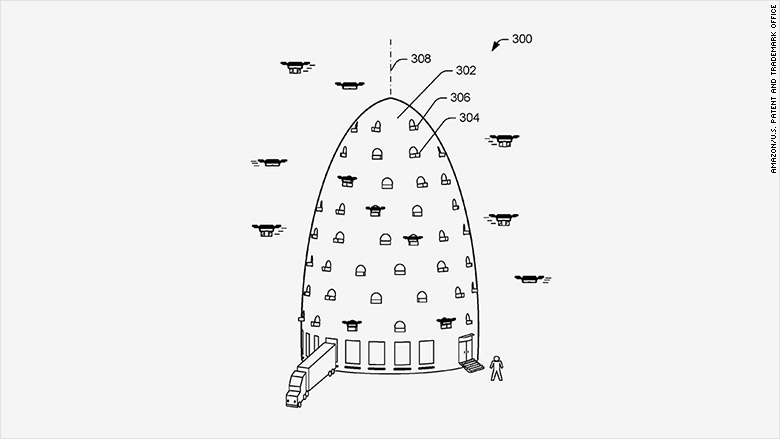
Robohub.org
The Drone Center’s Weekly Roundup: 6/24/17
June 19, 2017 – June 25, 2017
At the Center for the Study of the Drone
In an interview with Robotics Tomorrow, Center for the Study of the Drone Co-Director Arthur Holland Michel discusses the growing use of drones by law enforcement and describes future trends in unmanned systems technology.
News
The U.S. State Department is set to approve the sale of 22 MQ-9B Guardian drones to India, according to Defense News. The sale is expected to be announced during Prime Minister Narendra Modi’s visit to the United States. The Guardian is an unarmed variant of the General Atomics Aeronautical Systems Predator B. If the deal is approved and finalized, India would be the fifth country besides the U.S. and first non-NATO member to operate the MQ-9.
The United States shot down another armed Iranian drone in Syria. A U.S. F-15 fighter jet intercepted the Shahed-129 drone near the town of Tanf, where the U.S.-led coalition is training Syrian rebel forces. The shootdown comes just days after the U.S. downed another Shahed-129 on June 8, as well as a Syrian SU-22 manned fighter jet on June 18. (Los Angeles Times)
Meanwhile, a spokesperson for Pakistan’s Ministry of Foreign Affairs confirmed that the Pakistani air force shot down an Iranian drone. According to Nafees Zakaria, the unarmed surveillance drone was downed 2.5 miles inside Pakistani territory in the southwest Baluchistan province. (Associated Press)
A U.S. Air Force RQ-4 Global Hawk drone crashed in the Sierra Nevada mountains in California. The RQ-4 is a high-altitude long-endurance surveillance drone. (KTLA5)
The U.S. House of Representatives and Senate introduced bills to reauthorize funding for the Federal Aviation Administration. Both bills include language on drones. The Senate bill would require all drone operators to pass an aeronautical knowledge test and would authorize the FAA to require that drone operators be registered. (Law360)
President Trump spoke with the CEOs of drone companies at the White House as part of a week focused on emerging technologies. Participants discussed a number of topics, including state and local drone laws and drone identification and tracking technologies. (TechCrunch)
The Pentagon will begin offering an award for remote weapons strikes to Air Force personnel in a variety of career fields, including cyber and space. The “R” device award was created in 2016 to recognize drone operators. (Military.com)
The U.S. Federal Aviation Administration has formed a committee to study electronic drone identification methods and technologies. The new committee is comprised of representatives from industry, government, and law enforcement. (Press Release)
Commentary, Analysis, and Art
At MarketWatch, Sally French writes that in the meeting at the White House, some CEOs of drone companies argued for more, not fewer, drone regulations. (MarketWatch)
At Air & Space Magazine, James R. Chiles writes that the crowded airspace above Syria could lead to the first drone-on-drone air war.
At Popular Science, Kelsey D. Atherton looks at how fighter jets of the future will be accompanied by swarms of low-cost armed drones.
At Drone360, Leah Froats breaks down the different drone bills that have recently been introduced in Congress.
At Motherboard, Ben Sullivan writes that drone pilots are “buying Russian software to hack their way past DJI’s no fly zones.”
At Bloomberg Technology, Thomas Black writes that the future of drone delivery hinges on precise weather predictions.
At Aviation Week, James Drew writes that U.S. lawmakers are encouraging the Air Force to conduct a review of the different MQ-9 Reaper models that it plans to purchase.
Also at Aviation Week, Tony Osborne writes that studies show that European governments are advancing the implementation of drone regulations.
At The Atlantic, Marina Koren looks at how artificial intelligence helps the Curiosity rover navigate the surface of Mars without any human input.
At Phys.org, Renee Cho considers how drones are helping advance scientific research.
At Ozy, Zara Stone writes that drones are helping to accelerate the time it takes to complete industrial painting jobs.
At the European Council on Foreign Relations, Ulrike Franke argues that instead of following the U.S. example, Europe should develop its own approach to acquiring military drones.
At the New York Times, Frank Bures looks at how a U.S. drone pilot is helping give the New Zealand team an edge in the America’s Cup.
At Cinema5D, Jakub Han examines how U.S. drone pilot Robert Mcintosh created an intricate single-shot fly-through video in Los Angeles.
Know Your Drone
Amazon has filed a patent for multi-storey urban fulfilment centers for its proposed drone delivery program. (CNN)
Airbus Helicopters has begun autonomous flight trials of its VSR700 optionally piloted helicopter demonstrator. (Unmanned Systems Technology)
Italian defense firm Leonardo unveiled the M-40, a target drone that can mimic the signatures of a number of aircraft types. (FlightGlobal)
Defense firm Textron Systems unveiled the Nightwarden, a new variant of its Shadow tactical surveillance and reconnaissance drone. (New Atlas)
Israeli defense firm Elbit Systems unveiled the SkEye, a wide-area persistent surveillance sensor that can be used aboard drones. (IHS Jane’s 360)
Researchers at the University of California, Santa Barbara have developed a WiFi-based system that allows drones to see through solid walls. (TechCrunch)
Israeli drone maker Aeronautics unveiled the Pegasus 120, a multirotor drone designed for a variety of roles. (IHS Jane’s 360)
U.S. firm Raytheon has developed a new variant of its Coyote, a tube-launched aerial data collection drone. (AIN Online)
Drone maker Boeing Insitu announced that it has integrated a 50-megapixel photogrammetric camera into a variant of its ScanEagle fixed-wing drone. (Unmanned Systems Technology)
Telecommunications giant AT&T is seeking to develop a system to mount drones on ground vehicles. (Atlanta Business Chronicle)
U.S. defense contractor Northrop Grumman demonstrated an unmanned surface vehicle in a mine-hunting exercise in Belgium. (AUVSI)
Israeli firm Rafael Advanced Defense Systems unveiled a new radar and laser-based counter-drone system called Drone Dome. (UPI)
French firm Reflet du Monde unveiled the RDM One, a small drone that can be flown at ranges of up to 300 kilometers thanks to a satellite link. (Defense News)
RE2 Robotics is helping the U.S. Air Force build robots that can take the controls of traditionally manned aircraft. (TechCrunch)
The U.S. Marine Corps is set to begin using its Nibbler 3D-printed drone in active combat zones in the coming weeks. (3D Printing Industry)
U.S. drone maker General Atomics Aeronautical Systems has completed a design review for its Advanced Cockpit Block 50 Ground Control Station for U.S. Air Force drones. (UPI)
Researchers at NASA’s Langley Research Center are developing systems for small drones that allows them to determine on their own if they are suffering from mechanical issues and find a place to land safely. (Wired)
The inventor of the Roomba robotic vacuum cleaner has unveiled an unmanned ground vehicle that autonomously finds and removes weeds from your garden. (Business Insider)
Drones at Work
A group of public safety agencies in Larimer County, Colorado have unveiled a regional drone program. (The Coloradoan)
Five marijuana growing operations in California will begin using unmanned ground vehicles for security patrols. (NBC Los Angeles)
The Fargo Fire Department in North Dakota has acquired a drone for a range of operations. (KFGO)
The Rochester Police Department in Minnesota has acquired a drone for monitoring patients suffering from Alzheimer’s and other disorders. (Associated Press)
Drone maker Parrot and software firm Pix4D have selected six researchers using drones to study the impacts of climate change as the winners of an innovation grant. (Unmanned Aerial Online)
The Coconino County Sheriff’s Office and the Flagstaff Police Department used an unmanned ground vehicle to enter the home of a man who had barricaded himself in a standoff. (AZ Central)
Industry Intel
The U.S. Special Operations Command awarded Boeing Insitu and Textron Systems contracts to compete for the Mid-Endurance Unmanned Aircraft Systems III drone program. (AIN Online)
The U.S. Navy awarded Arête Associates a $8.5 million contract for the AN/DVS-1 COBRA, a payload on the MQ-8 Fire Scout. (DoD)
The U.S. Army awarded Raytheon a $2.93 million contract for Kinetic Drone Defense. (FBO)
The Spanish Defense Ministry selected the AUDS counter-drone system for immediate deployments. The contract is estimated to be worth $2.24 million. (GSN Magazine)
The European Maritime Safety Agency selected the UMS Skeldar for border control, search and rescue, pollution monitoring, and other missions. (FlightGlobal)
The Belgian Navy awarded SeeByte, a company that creates software for unmanned maritime systems, a contract for the SeeTrack software system for its autonomous undersea vehicles. (Marine Technology News)
A new company established by the Turkish government will build engines for the armed Anka drone. (DefenseNews)
Italian defense firm Leonardo is seeking to market its Falco UAV for commercial applications. (Shephard Media)
Thales Alenia Space will acquire a minority stake in Airstar Aerospace, which it hopes will help it achieve its goal of developing an autonomous, high-altitude airship. (Intelligent Aerospace)
The Idaho STEM Action Center awarded 22 schools and libraries in Idaho $147,000 to purchase drones. (East Idaho News)
For updates, news, and commentary, follow us on Twitter. The Weekly Drone Roundup is a newsletter from the Center for the Study of the Drone. It covers news, commentary, analysis and technology from the drone world. You can subscribe to the Roundup here.
tags: Amazon, c-Aerial, Center for the Study of the Drone, Drone Weekly Roundup





